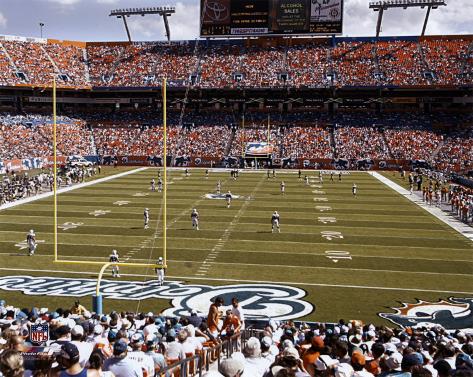

That effort was rewarded in July 1991, when the Miami area was awarded an MLB expansion franchise. In 1990, Wayne Huizenga purchased 50 percent of then-Joe Robbie Stadium and became the point man in the drive to bring Major League Baseball to south Florida. The Marlins move in File:Marlins 2008 001.jpg The Dolphins are 5–3 in playoff games held here, losing the most recent one in January, 2009, against the Baltimore Ravens. In addition to the Super Bowl, several other playoff games have been played in the stadium, including the 1992 AFC Championship Game, which the Dolphins lost to the Buffalo Bills, 29–10. The stadium hosted its first Monday Night Football game there on December 7 of that year, a 37–28 Dolphins victory over the New York Jets. The game was in the middle of the 1987 NFL strike, and was played with replacement players.

The first regular season NFL game played there was a 42–0 Dolphins victory over the Kansas City Chiefs on October 11, 1987. The stadium before a Miami Dolphins game, 2007 This resulted in a less intimate venue for football compared to other football facilities built around this time, as well as to the Orange Bowl. The wide field also makes it fairly easy to convert the stadium for soccer.īecause of this design decision, the first row of seats is 90 feet (27 m) from the sideline in a football configuration, considerably more distant than the first row of seats in most football stadiums (the closest seats at the new Soldier Field, for instance, are 55 feet (17 m) from the sideline at the 50-yard line). Most notably, the field was made somewhat wider than is normally the case for an NFL stadium. At his request, the stadium was built so only minimal renovations would be necessary to ready it for a baseball team. Robbie believed it was only a matter of time before a Major League Baseball team came to South Florida. For their first 20 years, the Dolphins played at the Orange Bowl.Ĭounty officials check out the interior of the stadium, 1987 Joe Robbie, founder of the Miami Dolphins, led the financing campaign to build a new home for his team.

The deal is worth $7.5 million per year for five years (a total of $37.5 million). On January 18, 2010, the Miami Dolphins signed a five-year deal with Sun Life Financial to rename Dolphin Stadium to Sun Life Stadium.
PROPLAYER STADIUM PRO
The stadium served as host for the second round of the 2009 World Baseball Classic, WrestleMania XXVIII, and hosted the 2010 Pro Bowl.
PROPLAYER STADIUM SERIES
Since its construction, the stadium has hosted five Super Bowls ( XXIII, XXIX, XXXIII, XLI and XLIV), two World Series ( 19), four BCS National Championship Games ( 2001, 2005, 2009, 2013), and constantly changing names. Originally named Joe Robbie Stadium, it has also been known as Pro Player Park, Pro Player Stadium, Dolphin Stadium, Dolphins Stadium, and Land Shark Stadium. It was the home to the Florida Marlins baseball team from 1993 to 2011. It also hosts the Orange Bowl, an annual college football bowl game. It is the home stadium of the Miami Dolphins National Football League team, and the University of Miami Hurricanes football team. Sun Life Stadium is an American football stadium in Miami Gardens, Florida, a suburb of Miami. University of Miami Hurricanes ( NCAA) (2008–present)ĭiscover Orange Bowl ( NCAA) (1996–1998)(2000–present)įlorida Atlantic Owls ( NCAA) (2001–2002)Ĩ0,120 ( 2013 BCS National Championship Game)

Prescription Athletic Turf (Natural Grass)


 0 kommentar(er)
0 kommentar(er)
